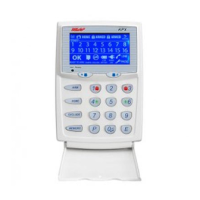NESS D16 CONTROL PANEL - USER MANUAL
5
INTRODUCTION
The Ness D16 micro computer based 16 zone
control panel is the heart of your security system
to which all your detection devices connect.
Each Zone of the panel can be connected to one
or more detection devices to protect separate
rooms of your premises.
Detection devices may be connected to the D16
control system directly by cabling or with optional
wireless (Radio) devices.
Detection devices called Passive Infra-Red
Detectors (or P.I.R’s for short) can detect the
movement of an intruder by sensing their body
heat. P.I.R’s are used to cover various critical areas
of your premises where an intruder may enter or
trespass. Another detection device used is called a
Reed Switch. Reed Switches are attached to
windows and doors to detect if a window or door
has been opened. A Reed Switch consists of a
magnet which is normally attached to the moving
part of a window or door and the Reed switch
which mounts to the door or window frame.
The panel is “Armed” when it is set to detect an
intruder. At other times it is “Disarmed”.
Normally a zone is considered Sealed. Activation
of a detection device will cause the zone to be
Unsealed and may cause an alarm.
Detectors such as fire detectors and panic buttons
must be able to generate an alarm at all times
regardless of the panel setting. A zone with this
assignment is called a 24 hour zone.
Some detection devices may be required to
generate an alarm or warning only when the panel
is Disarmed. A zone with this assignment is called
a Day zone.
Before leaving the premises you must Arm the
panel to enable it to detect intruders and generate
an alarm. After arming, the panel will ignore
detectors during the Exit Delay Time to enable you
to depart without triggering an alarm.
Arming the system may be done through the
keypad or with the use of optional Radio Keys for
Arming by remote control from outside the
premises.
When you enter the premises the panel will ignore
selected zones for the Entry Delay Time and will
not alarm unless you don’t Disarm the panel during
this allowed time.
Disarming the system may be done by keypad or
with the use of optional Radio Keys.
Monitor mode allows selected zones to be Armed
while leaving others Disarmed if you wish to
protect a number of zones while you are at home.
If you wish to split your alarm system into two areas
with access limited to each area by code numbers
then Area operation is used. Radio Keys can also
Arm and Disarm Areas.
The control panel housing and the covers over
external sirens are protected by tamper switches
to detect someone attempting to disable the
security system. Activation of these switches will
cause an instant tamper alarm.
If a detector becomes faulty, you can Exclude the
associated zone so that it is totally ignored and
cannot generate an alarm. Including the zone will
enable it to generate an alarm again.
The control panel is fitted with a rechargeable
stand-by battery to ensure your security system
continues to operate if the mains power is
interrupted. This control panel automatically tests
the battery every hour and whenever you Arm/
Disarm the panel. (Dynamic Battery test).
Whenever an alarm occurs, it may be silenced with
a User Code or by optional Radio Keys, otherwise
it will reset at the end of Alarm Reset Time.
All alarms are stored in memory and may be
viewed at any time by entering Memory Mode.
Technical Manuals Online! - http://www.tech-man.com

